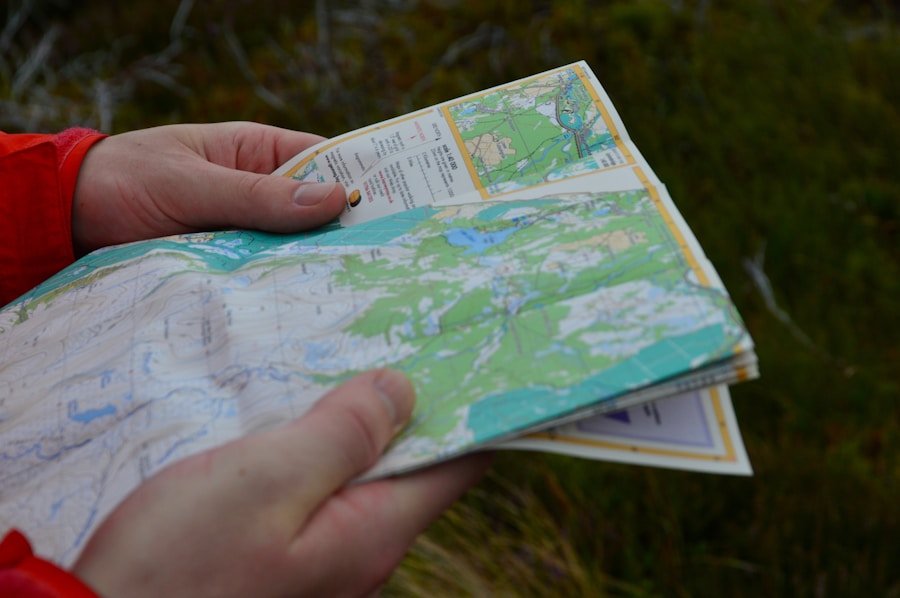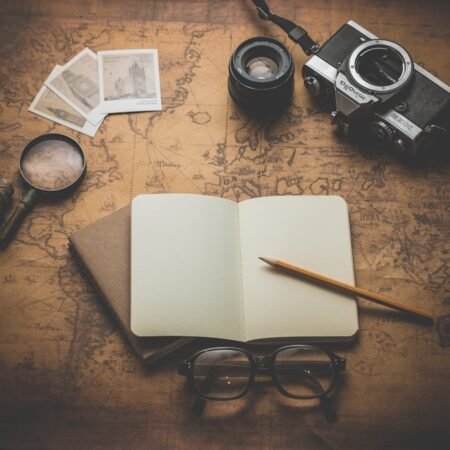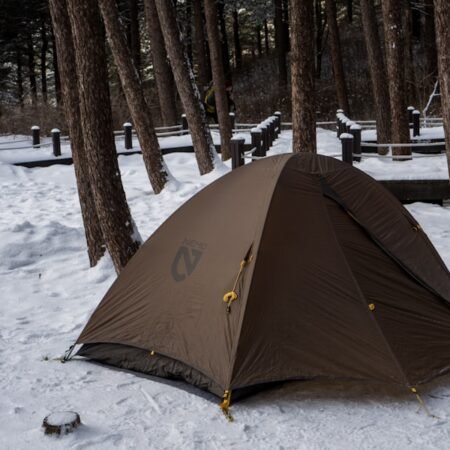Orienteering is an exhilarating outdoor activity that involves navigating through natural environments using a map and compass. It’s an excellent way to add excitement to your camping trip and explore the outdoors in a unique and thrilling manner. The fundamental objective of orienteering is to locate a series of checkpoints marked on a map within a specified time frame, relying solely on a compass and personal navigational skills.
This activity provides an excellent opportunity to challenge oneself and assess one’s ability to navigate through unfamiliar terrain. To begin with orienteering, it’s essential to familiarize yourself with the fundamental principles of map reading and compass navigation. Understanding how to interpret topographic maps, including contour lines, is crucial for successful orienteering.
Additionally, learning how to use a compass to determine direction of travel and navigate towards a desired destination is vital. It’s crucial to practice these skills in a controlled environment before venturing into the wilderness, as navigation errors can result in getting lost. Once you have a solid grasp of the basic principles of orienteering, you can start planning your first orienteering adventure.
Look for local orienteering clubs or events in your area where you can practice your skills and learn from experienced orienteers. Many clubs offer beginner-friendly courses and workshops to help newcomers get started with orienteering. It’s also recommended to start with shorter, easier courses and gradually progress to more challenging terrain as you gain confidence and experience.
Key Takeaways
- Orienteering adds adventure and excitement to your camping trip by challenging you to navigate the wilderness using only a map and compass.
- The basics of orienteering are easy to learn, making it a great activity for beginners looking to explore the great outdoors.
- To get started with orienteering, you’ll need basic equipment such as a map, compass, and possibly a GPS device to help you navigate the wilderness.
- Top tips for mastering orienteering include studying the map before you start, using natural landmarks to aid navigation, and staying aware of your surroundings at all times.
- Orienteering challenges add an extra layer of adventure to your camping trip, as you search for hidden checkpoints in the wilderness while honing your navigation skills.
Orienteering Equipment: What You Need to Get Started
Essential Equipment: Compass and Map
The most essential piece of equipment for orienteering is a good quality compass. A baseplate compass with a clear base and rotating bezel is ideal for orienteering, as it allows you to easily plot your course on the map and take accurate bearings in the field. It is important to invest in a reliable compass that you can trust to help you navigate through the wilderness. In addition to a compass, you will also need a topographic map of the area where you will be orienteering. Topographic maps show the natural features of the land, such as hills, valleys, and bodies of water, as well as man-made features like roads and buildings.
Choosing the Right Map
It is important to choose a map that is suitable for orienteering, with a scale of 1:15,000 or 1:10,000 being ideal for most courses. Many orienteering events provide participants with specially designed maps for the course, but it is also possible to purchase maps of popular orienteering areas from outdoor retailers.
Footwear and Clothing
Comfortable and sturdy footwear is also essential for orienteering, as you will be walking or running through varied terrain. A good pair of hiking boots with ankle support and good traction is recommended for most orienteering courses. It is also important to dress appropriately for the weather and terrain, with lightweight, moisture-wicking clothing being ideal for most conditions.
Additional Essentials
Carrying a small backpack with water, snacks, and basic first aid supplies is also a good idea, especially if you will be venturing into remote areas.
Top Tips for Mastering Orienteering in the Wilderness
Mastering orienteering in the wilderness takes time and practice, but there are several tips that can help you improve your skills and become a more confident navigator. One of the most important things to remember when orienteering is to always keep track of your location on the map. It is easy to become disoriented in unfamiliar terrain, so regularly checking your map and compass to confirm your position is essential for staying on course.
Another important tip for mastering orienteering is to plan your route carefully before setting out on the course. Take the time to study the map and identify prominent features that can help guide you along your intended route. Look for distinct landmarks such as hills, valleys, and bodies of water that can serve as reference points while navigating through the wilderness.
Planning your route in advance can help you avoid unnecessary detours and make efficient use of your time on the course. It is also important to maintain a steady pace while orienteering, especially in challenging terrain. Walking or running too fast can lead to mistakes and missed checkpoints, while moving too slowly can waste valuable time.
Finding a comfortable pace that allows you to navigate accurately while making good progress is key to successful orienteering. It is also important to stay focused and maintain good situational awareness while on the course, as distractions can lead to errors in navigation.
The Thrill of the Hunt: Finding Hidden Checkpoints in Orienteering
| Metrics | Data |
|---|---|
| Number of Orienteering Participants | 150 |
| Distance Covered | 10 miles |
| Number of Checkpoints | 15 |
| Time Taken | 4 hours |
One of the most exciting aspects of orienteering is the thrill of finding hidden checkpoints scattered throughout the wilderness. Checkpoints are marked on the map with specific symbols and are typically located at distinct features such as hilltops, trail junctions, or rock formations. The challenge of locating these checkpoints using only a map and compass adds an element of excitement and adventure to the orienteering experience.
As you navigate through the wilderness in search of checkpoints, it is important to keep a sharp eye out for prominent features that match those depicted on the map. Look for distinct landmarks such as boulders, trees, or changes in terrain that can help guide you towards the checkpoint. It is also helpful to take note of any natural or man-made features that can serve as reference points while navigating towards the checkpoint.
When you reach a checkpoint, be sure to punch your control card with the unique marker located at each checkpoint. This serves as proof that you have successfully found the checkpoint and allows event organizers to track your progress on the course. It is important to punch your control card in the correct box corresponding to each checkpoint, as missing punches can result in penalties or disqualification from the event.
Safety First: Navigating the Wilderness with Confidence
Navigating through the wilderness can be an exhilarating experience, but it is important to prioritize safety while orienteering. Before setting out on an orienteering course, be sure to familiarize yourself with any potential hazards or risks in the area. This may include steep terrain, bodies of water, or areas with dense vegetation that can make navigation more challenging.
It is also important to let someone know your intended route and estimated time of return before heading out on an orienteering adventure. This ensures that someone is aware of your whereabouts in case of an emergency or if you fail to return at the expected time. Carrying a whistle or signaling device can also be helpful for attracting attention in case you become lost or injured while on the course.
In addition to taking precautions before heading out on an orienteering adventure, it is important to stay aware of your surroundings while on the course. Keep an eye out for potential hazards such as slippery rocks, unstable terrain, or wildlife that may pose a threat. It is also important to stay hydrated and well-nourished while navigating through the wilderness, especially on longer courses or in hot weather.
Orienteering Challenges: Adding Adventure to Your Camping Trip
Explore New Areas and Test Your Skills
Orienteering offers a unique way to add adventure to your camping trip by exploring new areas and testing your navigational skills in unfamiliar terrain. Whether you are camping in a national park, state forest, or remote wilderness area, there are likely opportunities for orienteering nearby that can add excitement and challenge to your outdoor experience.
Find a Course That Suits You
Many campgrounds and outdoor recreation areas offer orienteering courses that are suitable for beginners and experienced navigators alike. These courses are typically designed with varying levels of difficulty and terrain, allowing participants to choose a course that matches their skill level and comfort in navigating through the wilderness.
Take It to the Next Level with Adventure Races
In addition to traditional orienteering courses, there are also adventure races and multi-day events that combine orienteering with other outdoor activities such as hiking, mountain biking, or paddling. These events offer a unique opportunity to challenge yourself physically and mentally while exploring new areas and enjoying the natural beauty of the wilderness.
Create Lasting Memories
Participating in an orienteering event during your camping trip can create lasting memories and provide a sense of accomplishment as you navigate through challenging terrain.
Orienteering as a Team Building Activity: Strengthening Bonds in the Great Outdoors
Orienteering is not only a great individual challenge but also an excellent team building activity that can strengthen bonds and foster camaraderie in the great outdoors. Working together with friends, family, or colleagues to navigate through unfamiliar terrain can create a sense of unity and cooperation that transcends traditional team building exercises. Team orienteering events often require participants to work together to solve navigational challenges and find checkpoints scattered throughout the wilderness.
This requires effective communication, problem-solving skills, and trust in one another’s abilities. Successfully completing an orienteering course as a team can create a sense of accomplishment and build confidence in each team member’s ability to contribute towards a common goal. In addition to traditional team building events, many organizations offer corporate orienteering programs that are specifically designed to promote teamwork and leadership skills among employees.
These programs often include workshops and activities that focus on communication, decision-making, and problem-solving within a team setting. Orienteering can be an effective way for organizations to foster collaboration and build stronger relationships among employees while enjoying the natural beauty of the outdoors. In conclusion, mastering orienteering adds adventure to your camping trip by providing an exciting way to explore new areas and test your navigational skills in unfamiliar terrain.
By familiarizing yourself with the basics of orienteering, investing in essential equipment, and following top tips for success, you can become a confident navigator in the wilderness. The thrill of finding hidden checkpoints adds excitement to the orienteering experience, but it is important to prioritize safety while navigating through the wilderness. Orienteering challenges can add adventure to your camping trip by breaking up routine activities and providing opportunities for exploration and accomplishment.
Additionally, orienteering serves as an excellent team building activity that strengthens bonds and fosters camaraderie in the great outdoors. Whether you are new to orienteering or an experienced navigator, adding this thrilling activity to your camping trip can create lasting memories and provide a sense of accomplishment as you navigate through challenging terrain.
FAQs
What is orienteering?
Orienteering is a sport that involves navigating through unfamiliar terrain using a map and compass to find specific checkpoints in the fastest time possible.
How does orienteering add adventure to a camping trip?
Orienteering adds adventure to a camping trip by providing a challenging and engaging activity that allows campers to explore and navigate the wilderness in a unique and exciting way.
What skills are needed for orienteering?
Orienteering requires skills such as map reading, compass navigation, decision making, and physical fitness. Participants also need to have a good understanding of their surroundings and be able to adapt to changing terrain.
Is orienteering suitable for all ages and fitness levels?
Orienteering can be enjoyed by people of all ages and fitness levels. Courses can be tailored to different abilities, and participants can choose their level of difficulty based on their experience and physical capabilities.
What equipment is needed for orienteering?
The main equipment needed for orienteering includes a map, compass, and appropriate outdoor clothing and footwear. Some participants may also use GPS devices or orienteering markers to aid in navigation.
Are there orienteering events and competitions available for participation?
Yes, there are orienteering events and competitions held at local, national, and international levels. These events offer opportunities for individuals and teams to test their orienteering skills and compete against others in a variety of settings.













